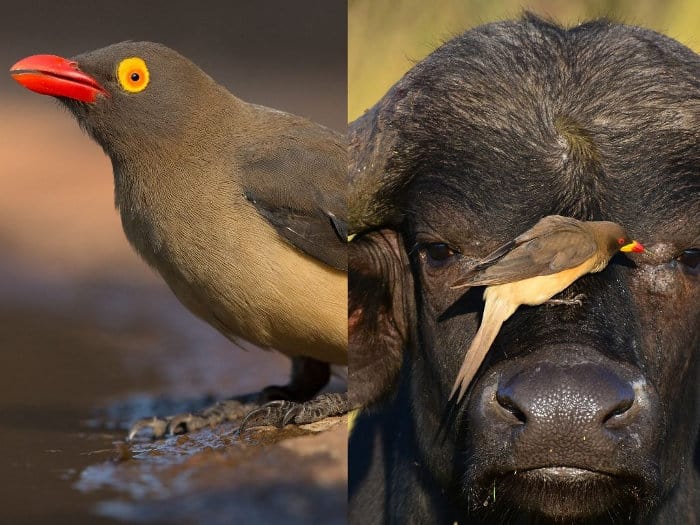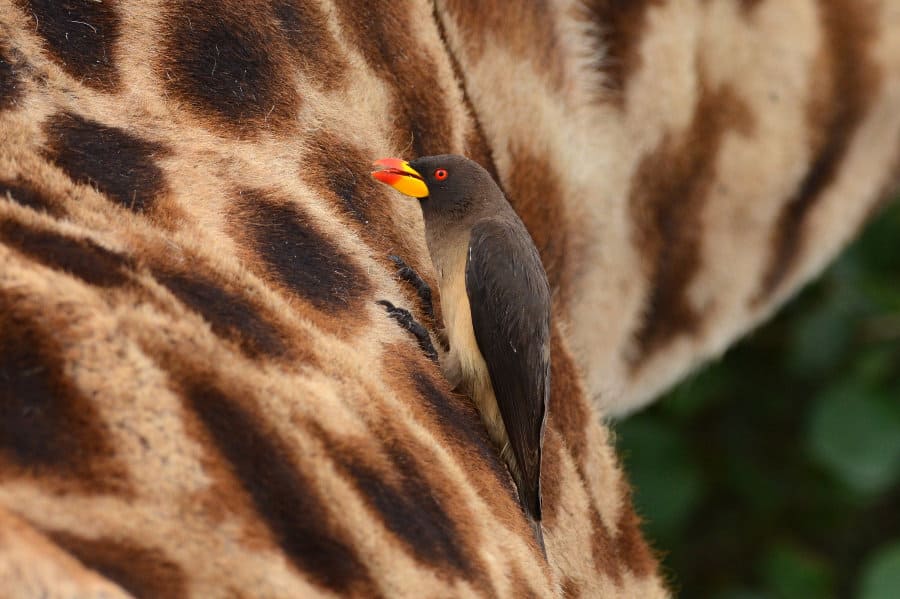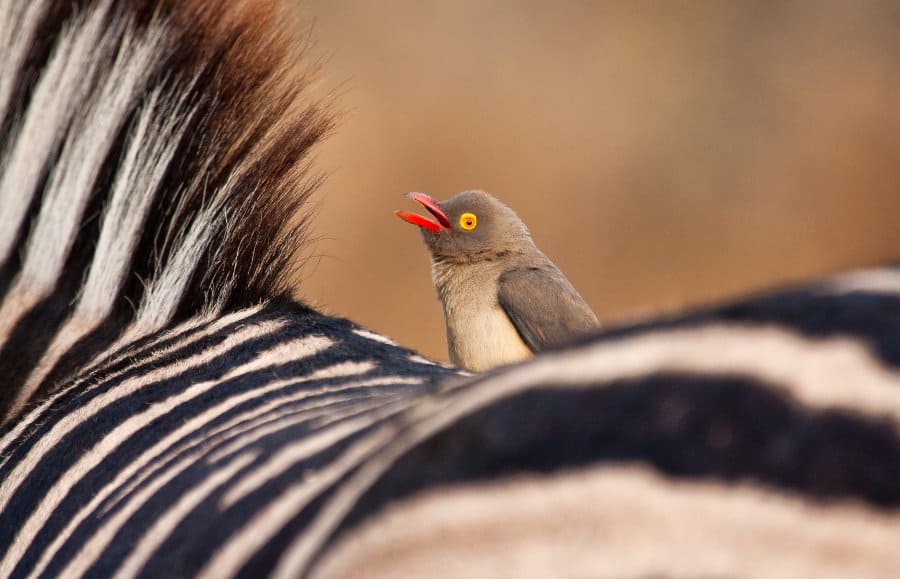Although they are called tickbirds, yellow-billed oxpeckers aren’t actually birds that are mistaken for ticks. They are only called tick birds because they eat ticks, among other things. To many, they are simply the courageous bird that sits on a rhino, feeding endlessly.
The yellow-billed oxpecker is the cousin of the red-billed oxpecker. Both live in Africa, and both look somewhat similar, except for the coloring, and a few other interesting aspects.
Let’s learn about those aspects. The two oxpecker species share similarities, yet they are different in some ways. Here’s what we know about the cute Buphagus species, that allows the oxpecker to play such a significant role in so many grazers’ personal hygiene.
The Scientific Name Reveals a Lot

Here’s a fun fact to impress your friends with when you discuss oxpeckers. The genus name is Buphagus. It derives from the Greek words bous (meaning “ox”) and phagos (meaning “eating”).
It’s funny when you describe this little bird as an ox-eater. The yellow-billed oxpecker is Buphagus africanus, while the red-billed oxpecker species is Buphagus erythrorhynchus.
What is an Oxpecker Bird?
The oxpecker genus consists of two species – the yellow-billed and red-billed oxpecker. They are roughly the same size – about 20 cm long at full size. Both inhabit broad areas in sub-Saharan Africa, largely wherever you find larger grazing animals.
Chances are when you see African rhino, buffalo, zebra, or giraffe, you’ll spot an oxpecker sitting on the animal at some point.
It seems that these animals don’t mind the oxpecker presence, as they eat annoying ticks, flies, maggots, and other pests. One oxpecker can easily eat several hundred bugs a day!
Red-Billed and Yellow-Billed Oxpecker – What’s the Difference?

The main and most obvious difference is in the beak. It’s in the name. The red-billed oxpecker has a red bill and a yellow ring around its eye. The yellow-billed oxpecker has a yellow base on its bill and no ring around the eye.
The yellow-billed tends to have a less vivid plumage as well, although its rump color may be different from its body. Experts classify both species as “brown birds.”
Keen observers will notice another distinction. When the birds are in action, there is a difference in how they use their beaks to get to ticks and fleas. Reds tend to “slice” or “comb” through the hairs of a hide similar to a scissor motion.
Yellows peck at their host customers, getting at those insect larvae and dug-in ticks with more force. It is likely that the yellow’s thicker beak allows it a more aggressive motion when dealing with its “prey.”
Where Do Oxpeckers Live?
Interesting fact: Between the late 1800s and 1979, researchers believed that yellow-billed oxpeckers were extinct in South Africa. They were not seen in the region until a sighting in the Kruger National Park in 1979 that baffled experts.
Today, the yellow-billed oxpeckers inhabit most of sub-Saharan and east and west Africa, although they are not found in rainforests or deserts.
The red-billed species seems to stick mostly to the eastern parts of Africa. Sometimes, you can spot both species in the same region. They don’t seem to bother each other in terms of territorial disputes.
Life Span and Breeding

Oxpeckers live for around 15 years, which is a decent age for their size. When breeding, one breeding pair (oxpeckers mate for life) lays eggs, while 5 or 6 other individuals help rear the chicks.
The parasite-eating birds build their nests in tree cavities – holes in trees or old woodpecker boreholes. Sometimes they’ll even find spaces in wooden farm building walls.
The female will lay 2-3 eggs, which will incubate for around two weeks. Once hatched, parents and helpers will take turns to feed and rear the chicks, and the young birds will fledge at around 25 days.
A Few Other Yellow-Billed “Tick Bird” Facts
Here are some random other facts about our cute oxpeckers:
- They go by other names like hippo birds or hippopotamus birds, rhino birds, giraffe birds, tick birds, or ox birds.
- Oxpecker’s mating often takes place when the birds are sitting on their host animals. This may seem a little rude, but the big beasts don’t seem to mind all the fuss.
- Far from being totally friendly and docile, oxpeckers can get pretty aggressive going after food, even when riding along on their hosts. When you see a big group on an animal’s back, chances are there’ll be a scuffle sooner or later.
- Oxpeckers sometimes take hair and fur from their hosts to help build their nests.
- The scientific community disagrees on whether oxpeckers and their hosts have a mutually beneficial relationship, or whether oxpeckers can be bad for their hosts. Mostly, they are unsure whether picking at a host’s wounds prevents them from healing.
- Oxpeckers have strong claws and stiff tails. Both help to stabilize their hold onto other animals’ hides.
- You’ll often see a whole bunch of oxpeckers sitting on one animal. That’s called a “fling” of oxpeckers.
- The high screech of an alarmed oxpecker helps to warn host animals of danger. It’s not intentional, but helpful nonetheless.
- Some big animals like certain antelope and elephants seem to hate oxpeckers. They will wave them away and generally get very annoyed at their presence.
So Keep An Eye Out For the Tick Bird

The yellow and red-billed oxpeckers have a lot in common. However, they are separate species. They are easily told apart, and will generally be where the big, grazing tick-providing animals are.
They don’t seem to bother each other territorially, so you’re likely to see one or both quite easily on a safari – especially in the eastern regions of Africa.
Here are a few wonderful deals to consider if you’re thinking about a trip to Africa. Chances are, the bird that sits on rhinos will be around to welcome you.

